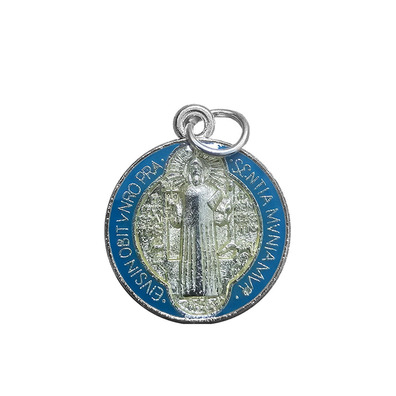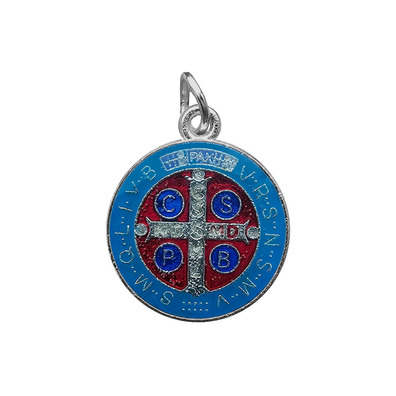St. Benedict Medal
1,50€
Taxes includedCatholic product in stock. Products ready to be shipped. You can check the approximate delivery time during the purchase process.
St. Benedict Medal | Buy Online
- St. Benedict medal made of metal.
- Polychrome finish.
- 1.7 cm in diameter.
- Includes a ring for hanging on a medal or pendant.
Medal colors: gold and silver
The Saint Benedict medal is a sacramental of the Catholic Church.
Traditionally, it features distinct elements such as the figure of St. Benedict with the Cross and the book, images of the chalice and the raven, and numerous inscriptions and initials of Latin expressions related to St. Benedict.
These traditional elements have been preserved over the centuries. However, the colors and materials of the Benedictine medal have evolved. There are silver St. Benedict medals and gold St. Benedict medals available for sale, etc.
The medal you can buy in our online store is made of metal and decorated with enameled colors. Our medal model is very colorful, you will find gold in the figure of the saint, silver in the outline of the piece, teal, red, etc.
History of St. Benedict
St. Benedict medals are religious objects that bear the image and cross of the saint who founded the Benedictine order. St. Benedict is considered the patron saint of Europe and a powerful protector against evil and temptations.
St. Benedict was born in Nursia, Italy, in the year 480. From a young age, he was drawn to monastic life and retired as a hermit to a cave in Subiaco, where he lived for several years. There he endured the devil's temptations, which tried to break his faith in God in various ways. The Saint remained steadfast and resisted through prayer and penance.
The fame of his unwavering faith spread throughout the region. Many people approached him for guidance and comfort. Seeing the need of the people, he decided to continue his service to God by creating several monasteries.
He founded twelve monasteries in Subiaco. After this, he decided to move to Montecassino. A place of great importance to his life, to Western monastic life in general, and to the Benedictine order in particular. In the Montecassino Abbey, St. Benedict wrote the Benedictine Rule, based on the motto "ora et labora" (pray and work) and the pursuit of individual and community peace.
He died in the year 547, surrounded by his disciples. He was canonized in the year 1220. His feast is celebrated on July 11.
Miracles of St. Benedict
St. Benedict was recognized for his wisdom and his ability to resolve conflicts. It is said that he performed several miracles, such as healing the sick, multiplying food, mastering the natural elements, and predicting the future.
According to tradition, St. Benedict made the sign of the cross over a glass of poisoned wine that had been offered to him, and the glass shattered.
One of the greatest miracles of St. Benedict was resisting the devil's temptations that tested him for years. The Saint remained firm in faith and in the word of Christ.
Prayer to Saint Benedict, the Novena
St. Benedict is a saint who is invoked as a protector against the devil and is prayed to seek his intercession before God. One way to do this is through the novena to St. Benedict, which consists of praying for nine days.
The St. Benedict Medal
The St. Benedict Medal is a religious object consisting of faces that blend elements related to his life and work of St. Benedict.
It is believed that the first St. Benedict medals appeared in the 17th century in the region of Bavaria (Germany).
Some sources mention that the first references to St. Benedict medals are found in texts related to a witchcraft trial. The accused claimed that they could not attack the Benedictine monastery because it was protected by the Cross. The monastery was protected by some inscriptions and a Cross.
The medal with the Cross of St. Benedict and the inscriptions that had protected the monastery began to be minted across the old continent.
Pope Benedict XIV approved the St. Benedict Medal in 1742. Since then, its popularity has only increased.
The obverse of the St. Benedict Medal
The obverse of the St. Benedict Medal shows the image of the saint with a Cross in his right hand and a book in his left. The Cross symbolizes the power of Christ over evil, and the book represents the Benedictine Rule.
On either side of the saint's figure is the Latin inscription Crux patris benedicti (Cross of Father Benedict). Additionally, two symbols of the protection with which God protected St. Benedict from all evil because of his unwavering faith: the chalice with the poisoned drink and the raven that took the poisoned piece of bread.
Around the medal, the inscription reads: "Eius in obitu nostro praesentia muniamur" (May we be strengthened by his presence at our death).
The reverse of the St. Benedict Medal
The reverse of the St. Benedict Medal symbolizes victory over evil (represented by the devil) and temptation.
St. Benedict had to face attacks from Satan, who tried to poison him and tempt him in various ways.
In the center of this side is located the Cross of St. Benedict. On the arms of the medal the initial letters C S S M L and ND S MD, which correspond to the Latin expressions "Crux Sacra Sit Mihi Lux" (The holy cross be my light) and "Non Draco Sit Mihi Dux" (Let not the dragon be my guide). These words express the desire to follow Christ and reject the devil.
In the gaps of the Cross are engraved the letters C S P B, which mean "Crux Sancti Patris Benedicti" (Cross of Saint Father Benedict).
Around the Cross, other letters form an exorcism prayer: "V R S N S M V S M Q L I V B", which mean "Vade retro Satana, nunquam suade mihi vana, sunt mala quae libas, ipse venena bibas" (Step back, Satan, do not suggest vain things to me, evil is what you offer, drink your own poisons).
At the top, the word "Pax" (Peace) is seen, which is one of the pillars of the way of life of the Benedictine order.
What benefits does wearing the St. Benedict Medal have? | Full and partial indulgences
The benefits that the St. Benedict Medal brings to its bearers are generally related to protection against the temptations of Satan.
Throughout life, it is common for the devil to present people with all kinds of offers that may shake their faith in God. The St. Benedict Medal is a Catholic sacramental that helps people stay firm against sin and the lies of the evil one.
In addition to protection, the St. Benedict Medal as a sacramental grants a series of full indulgences to people who meet a series of requirements. These conditions include the performance of the Sacrament of Reconciliation, the reception of the Eucharist, prayer for the Holy Father on notable dates within the liturgical calendar (Christmas, Epiphany, Easter, Ascension, Pentecost, the Most Holy Trinity, Corpus Christi, etc.), and the recitation of the Holy Rosary throughout the week. There must also be significant social and charitable work with the needy (visiting the sick, helping the poor, participating in the Holy Mass, etc.).
In addition to full indulgences, the medal can also grant partial indulgences.






